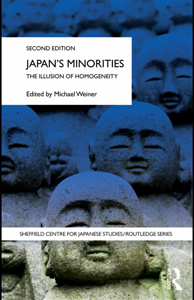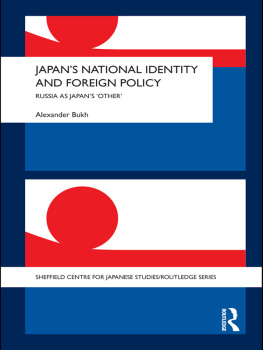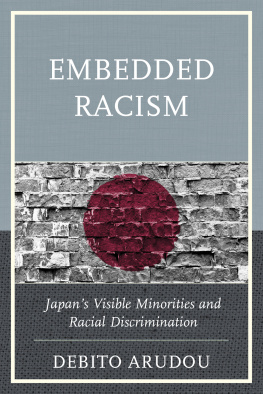1 Self9 and other9 in imperial Japan
Michael Weiner
Nationalisms are rarely consistent in content; what remains permanent are their bases in national consciousness. Depending upon the specific historical context, nationalism has most often been expressed in terms of economic or territorial expansion, the establishment of political sovereignty, or social and cultural norms of behaviour. In contrast, national consciousness, which serves as a pre-condition to the development of nationalism, implies the existence of historically embedded and culturally transmitted assumptions concerning the imagined community of the nation and its citizens. The modality of nationalism that emerged in the context of post-Restoration Japan was one that idealized cultural and racial homogeneity as the foundation of the nation state.
What had been a political, economic and social rupture was redefined to connote linkages with an ancient past, thus locating the events of 1868 within a continuous and unbroken chain of events culminating in the restoration of imperial rule. Paralleling this were the increasingly organized efforts by the new Meiji state to infuse a heterogeneous population with a sense of homogeneity and community (Fujitani 1993: 77-106). Along the way, powerful but selective cultural empathies were mobilized, while regional identities were either suppressed or subjected to a process of cultural redefinition, the objective of which was to bring reality into line with ideology. Within this framework, the kazoku kokka (family state) was projected as an enduring essence, which provided the state with an elevated iconography of consanguineous unity, enhanced the legitimacy of new economic, social and political relations, and provided the Japanese people with a new sense of national purpose and identity. It was a national identity forged from both indigenous and imported elements, and it rested upon the assumed unique qualities and capacities of the Japanese minzoku (Weiner 1995: 43342). The argument pursued here is that rather than existing as independent categories of inclusion and exclusion, race and nation inhabited the same ideological space, with each functioning to define the parameters of the other. Set within the dominant paradigm of minzoku, both race and nation were regarded as naturally occurring phenomena, further reinforcing their credibility as explanatory factors in social, political and economic relationships (Yoshino 1992: 25).
In erecting a set of new symbolic boundaries around Japan, the language, imagery and iconography of nationalism suggested that the nation was the modern manifestation of a primordial community of which the citizenry had always been a part (Yasuda 1992: 63). Set against the background of a radically transformed environment, the efforts of state propagandists, the selective revival of ancient institutions, as in the case of Jingikan (Department of Shinto Affairs), the transformation of local or folk shrines, as in the case of Ise, into sites of national memory and pilgrimage, and the invention of commemorative structures, linking an imagined imperial past with present accomplishments, were designed to connote, diffuse and sustain a particular landscape. The naturalization of culture, of which these processes formed an integral part, recast the meaning of Japaneseness in powerful images of the enduring purity and homogeneity of the nation, the family and the Japanese way of life. The nation was projected as an extended family, and the emperor was established as both head of state and semi-divine father to the national community. Ultimate sanctification of the imagined community was thus located at the sacred level, in Shinto, while reverence for the emperor as minzoku no osa (head of the people) and loyalty and obedience to the state were rendered equivalent (Gluck 1985: 91-3).
The conflation of cultural and racial criteria by which membership within the imagined community of the nation could be identified has assumed various guises. Anticipating the later genre of literature associated with the Nihonjinron and Nihon Bunka-ron, Takakusu Junjiro, in a 1938 publication, argued in favour of the existence of a dominant Yamato, or stem race, which had assimilated various prehistoric racial groupings. The consanguineous unity, or culture of the Japanese blood, to which Takakusu referred had subsequently been preserved through the virtuous rule of succeeding emperors. The putative relationship between blood and culture is made more explicit in Kada Tetsujis Jinshu Minzoku Senso (Jinshu, Minzoku and War), published in 1940. While the title implies a conceptual distinction between jinshu (race) and minzoku (ethnicity; people; nation), Kada consistently reaffirms the biological basis of minzoku. Indeed, for Kada, the origins of minzoku can only be found in the distinctive jinshuteki (racial) and seishinteki (spiritual) qualities of people. We cannot consider minzoku', he concludes, without taking into account its relation to blood (Kada 1940: 70-1). In arguing a biological or genetic basis for the distinctiveness and superiority of the Japanese people, Kada was also reinforcing what one writer has termed ketsuzokushugi (the ideology of the blood family) (Hayashida 1976: 82).
Parallels can also be drawn between the racial literature of the inter-war years and, for example, Hozumi Nobushiges 1901 publication, Ancestor Worship and Japanese Law (Kikuchi 1972: 2^5). Here, the imagined community of the nation was conceived as a consanguineous community comprised of three primary constituent elements (the imperial family, the regional clan and the family unit) (Ito 1982: 31-3).
The argument advanced in this present work is that social structures and attitudes in Japan have historically been imbued with racial meaning, and that these meanings are themselves dynamic and contingent. That is to say, both racial meanings and racialized identities are historically specific, and can only be understood in relation to other factors - economic and political - and in relation to the international environment within which they emerged and have since been reproduced (Gilroy 1990: 264-5). In developing this argument, I also suggest that the construction of a Japanese national identity has entailed the transformation of culture, through an overarching discourse of race, into a pseudobiological property of communal life (Gilroy 1990: 267). An objective here is to identify the various strands of racialized discourse that were developed during the period 1868-1945, and the channels through which European imperialist perspectives on race and native populations were domesticated within the Japanese context. In tracing the relationship between ideologies of race and nation in the construction of the modern Japanese identity, I seek also to identify the discursive elements that have informed perceptions of the excluded other (both external and internal) against whom this identity has been produced and reproduced at particular historical junctures.
New ideologies and configurations of social power do not emerge unchallenged within an empty space (Greenfeld 1992: 399403). As in Europe and North America, ideas of self and other in Japan were moulded both by the broader international context in which they evolved and through the appropriation of indigenous themes in Japanese history. The experts in legitimation who contributed to the diffusion of racial knowledge and the dissemination of scientific racism in Japan were themselves aware of and deeply influenced by European scholarship in particular (Shimao 1981: 93-8). The scientification of knowledge, of which these processes were an integral part, also provided the means by which the civilized self could be distinguished from the uncivilized other. Just as Meiji industrialization was dependent upon the prior existence of well-established market relations and the importation of Western capital and technology, in their construction of a national identity, Japanese ideologues drew inspiration from both the West and through the appropriation and manipulation of indigenous myths. The search for a usable past engaged the resources of academics, educators, journalists, politicians and government officials alike. Their interests and concerns often overlapped; politicians were frequent contributors to newspapers, while academics were often called upon to advise on matters of public policy and education. Although there was no master narrative to which they all subscribed, nor a smoothly orchestrated discourse imposed upon a passive audience, their efforts would assist in the dissemination of racial knowledge and the necessary production of otherness.
Next page







